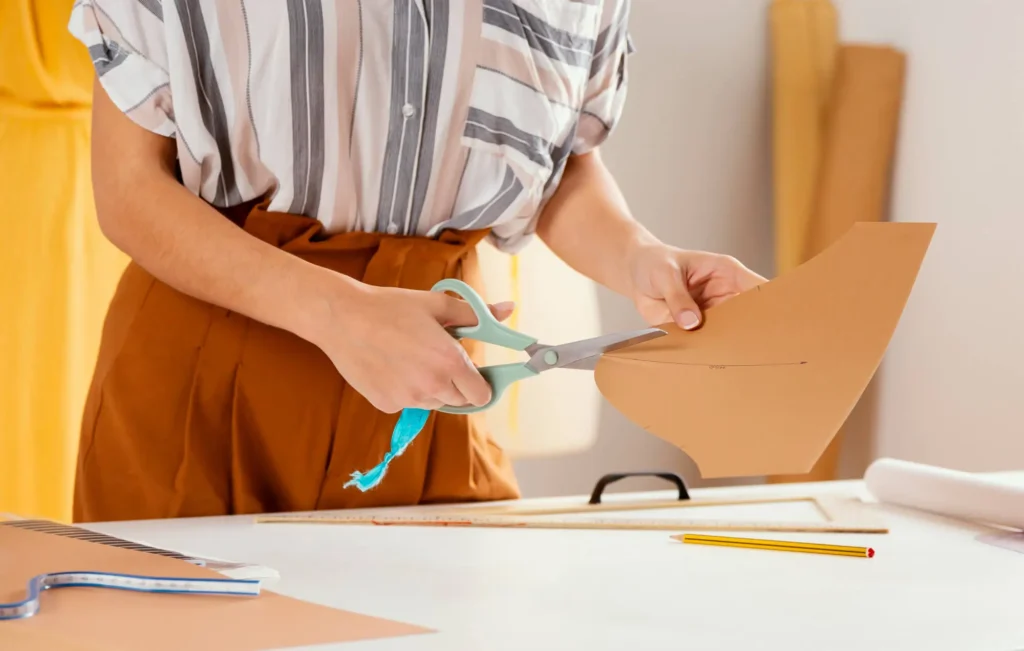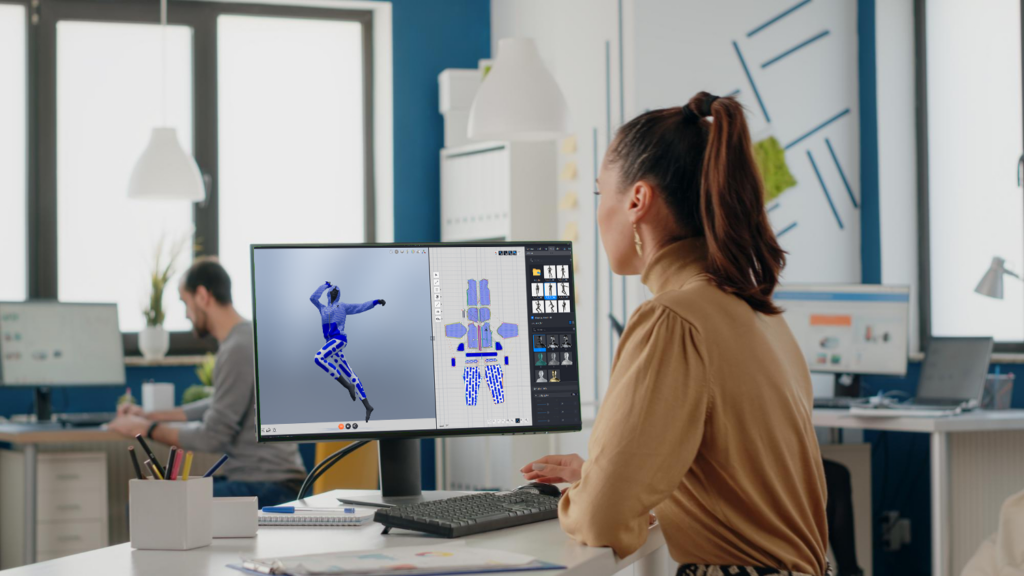Summary
- The method for creating a pattern of clothing varies depending on the type of design and the tools available.
- A pattern maker must be skilled in selecting the most appropriate to ensure the garment aligns with the initial proposal.
- Technology can significantly streamline this process. Discover how with Audaces360 free trial!
Achieving the perfect pattern of clothing isn’t always an easy task, especially when dealing with designs featuring intricate cutouts and details.
However, by employing the right techniques and tools, you can minimize rework and create patterns without trouble. With a little organization, you still can reuse them for future creations.
To streamline your pattern making process, we’ve compiled a collection of valuable tips. Read on to discover efficient methods for creating patterns of clothing.
Enjoy your reading!
Sumário
Why invest in creating more precise patterns of clothing?
In the fast-paced world of garment manufacturing, the need to create multiple patterns can lead to a busy workflow. It can potentially cause oversights and compromise accuracy.
However, a precise pattern of clothing is crucial for achieving high-quality garments that fit and drape well. By adopting standardized tasks and implementing effective techniques, you can streamline your process and ensure precision with ease.
Remember, pattern making is a continuous learning process! With practice, you will refine your skills and elevate your work.
Check out some of the benefits pursuing precision will bring:
Reduced errors and rework
When you work with patterns, it is possible to notice issues even before cutting the fabric. Thus, saving your time by avoiding rework.
Proportions and fit errors are the main reasons for remaking patterns. Therefore, whenever you make a pattern of clothing, check the measurements before using it to ensure they are all correct.
Learn more: Understand the importance of a pattern maker for fashion manufacturing
Minimal fabric waste
Using calculations and techniques to create a pattern of clothing eliminates the need for wasteful trial-and-error cutting on the fabric.
This saves resources and allows you to make a digital or paper pattern that perfectly fits the garment’s shape.
Patterns extend their usefulness into the production stage. They create markings for the cutting process, ensuring maximum fabric use.
Quality and efficiency
Well-crafted patterns ensure the quality of the final product. They are efficient and can serve as a base for future designs.
Once you’ve developed a perfect pattern of clothing, reuse it for new creations. This will streamline your workflow and ensure that future garments also embody quality and efficiency.
Learn more: 6 pattern making tools every fashion designer should use
What are the most common mistakes when creating patterns of clothing?
It’s important to pay attention to certain details to avoid small mistakes that can cause big headaches. Here are some of the most common ones to avoid:
Not considering the type of fabric
Different fabrics behave differently when draped over the body. Not considering the fabric’s drape can lead to a pattern that doesn’t translate well to the chosen material.
For example, a stiff fabric might not work well with a pattern of clothing designed for a flowy drape.
You also need to consider that some fabrics have stretch, while others don’t. If you don’t account for stretch in the pattern, the garment might be too tight or too loose.
Similarly, fabrics with poor recovery might lose their shape over time if the pattern doesn’t account for this.
Learn more: The best types of fabric for your clothing company
Ignoring clothing ergonomics
A pattern of clothing that doesn’t consider ergonomics might restrict natural movements like bending or sitting. This can be restrictive and impractical for everyday wear.
Remember, consumer demand for comfortable clothing has been steadily increasing in recent years.
Taking inspiration from existing garments you find is a great way to incorporate ergonomics into your patterns.
You can make a pattern from a piece of clothing by following some steps:
- Trace its outline on pattern paper: make sure to stretch the paper. It’s important to add a standard seam allowance, typically of 1-1.5 cm.
- Mirror the other side: ensure both sides of symmetrical pieces are identical.
- Create a test garment: use inexpensive fabric like calico. This allows you to test the fit and make any adjustments to the pattern before using your final fabric.
Learn more: Explore clothing pattern making techniques for your production
Using only physical patterns

Small mistakes during tracing or measuring a paper pattern of clothing can lead to differences in the final pattern.
Adjusting a physical pattern can be messy and time-consuming. You might need to tape or glue pieces together, making it difficult to visualize or reverse changes.
The most practical way to create patterns is through digital software. The available tools are a great help and with a little practice, you can create patterns without the risk of errors.
How can technology assist the development of a pattern of clothing?
Pattern making has evolved significantly with technology! What once took hours now takes some minutes and just a few clicks.
Streamlining the daily workflow
Instead of paper patterns of clothing, some CAD software allows for creating, editing, and storing patterns digitally.
They offer specialized tools for precise pattern creation like line drawing, curve adjustment, and mirroring. Another benefit is the ease of grading, ensuring consistency and quality across all sizes.
In addition, cutting-edge 3D technology allows for virtual sewing patterns and guarantees they fit the envisioned way.
This saves time, eliminates the risk of physical damage, and makes it easier to share and collaborate.
Learn more: 5 benefits of 3D modeling software in your apparel company
Making pattern making sustainable
Cutting out or at least reducing paper patterns of clothing reduces waste and contributes to a more sustainable workflow. This is because it usually takes several tests to achieve the desired pattern, which demands lots of paper.
3D modeling software can be an innovative solution, allowing for virtual prototyping of garments. It minimizes the need for physical samples and the associated fabric waste.
This approach helps pattern makers to make more informed choices and minimize the fashion industry’s ecological footprint.
Learn more: 8 sustainability trends to navigate the future of the textile industry
Stimulating creative freedom

3D simulation enables designers and pattern makers to test different ideas, drape effects, and fabric combinations before investing in physical samples.
These tools allow for creating a pattern of clothing based on user-defined parameters like sleeve length, waistline height, or skirt fullness.
It empowers pattern makers to explore a wider range of possibilities and create unique variations from a single base pattern. Available print libraries are also useful for exploring different combinations and visualizing how they will look.
Enhancing team communication
A great benefit of digital solutions is storing and organizing patterns in folders on a computer. Every time you make a change in the pattern and save the file, everyone on the team has access to the latest version.
Unlike the physical ones, there’s almost no risk of confusion caused by outdated or misplaced patterns.
Additionally, sharing a pattern of clothing becomes an easy task. Imagine the trouble of requesting an adjustment to a physical pattern if the pattern making is outsourced! With digital files, you can send or receive a pattern in seconds.
For even more comprehensive collection development tracking, you can also integrate a fashion PLM (Product Lifecycle Management). This provides real-time access to all changes and updates for all teams involved.
Learn more: 6 benefits of having an online collection management
Create precise patterns of clothing with less effort, 100% digital
Exploring the possibilities that technology offers is essential for developing patterns and standing out in the fashion industry.
Discover the solutions offered by Audaces, a global reference in fashion technology.

Audaces Pattern
For pattern makers looking for excellence, Audaces Pattern is an essential solution. It ensures the pattern of clothing creation reaches a new level of efficiency and precision.
With its dynamic and versatile approach, it is possible to develop high-quality patterns, regardless of complexity. Refine every detail to perfection, ensuring that your creative vision translates into patterns.
This important ally will help you in your journey towards success in the fashion industry. It will give you the confidence to stand out in the market!
Audaces 3D
Audaces 3D is the essential software for pattern makers to bring creations to life in a three-dimensional mannequin.
With a range of tools and possibilities, this software transforms the creative and development processes. Paper patterns of clothing days will soon be in the past!
It enables you to shape your ideas directly in a digital environment, gaining agility and quality in deliveries.
Are you a pattern maker looking to take your skills to the digital level? Learn how Audaces can streamline and elevate your work!
Discover how digital modeling works by downloading our free e-book!
FAQ
Precise pattern making is crucial for achieving high-quality garments that fit and drape well. Some benefits are reduced errors and rework, minimal fabric waste, and quality and efficiency.
Not considering the type of fabric, ignoring clothing ergonomics, and using only physical patterns.
Streamlining the daily workflow, making patternmaking sustainable, stimulating creative freedom, and enhancing team communication.






